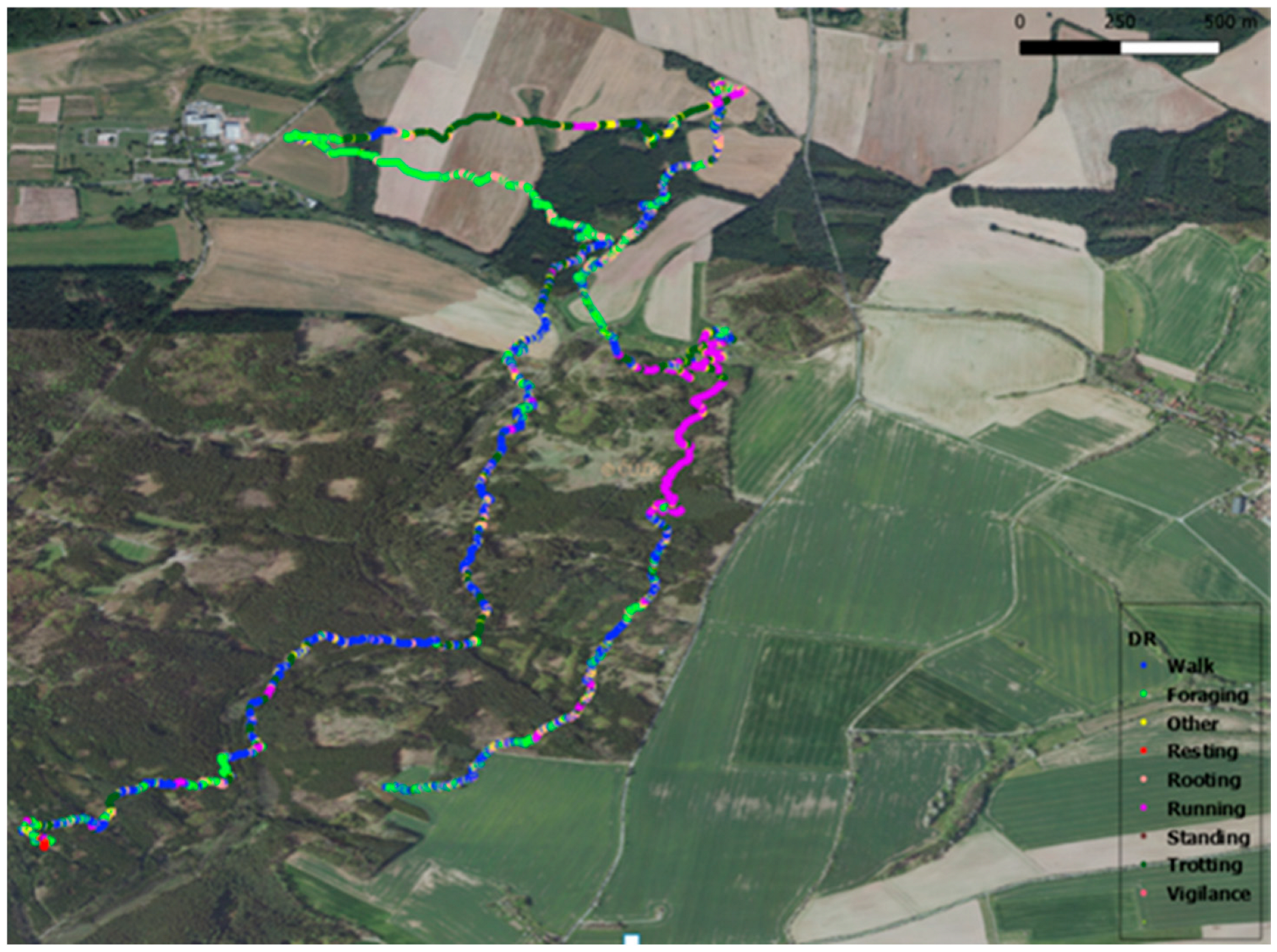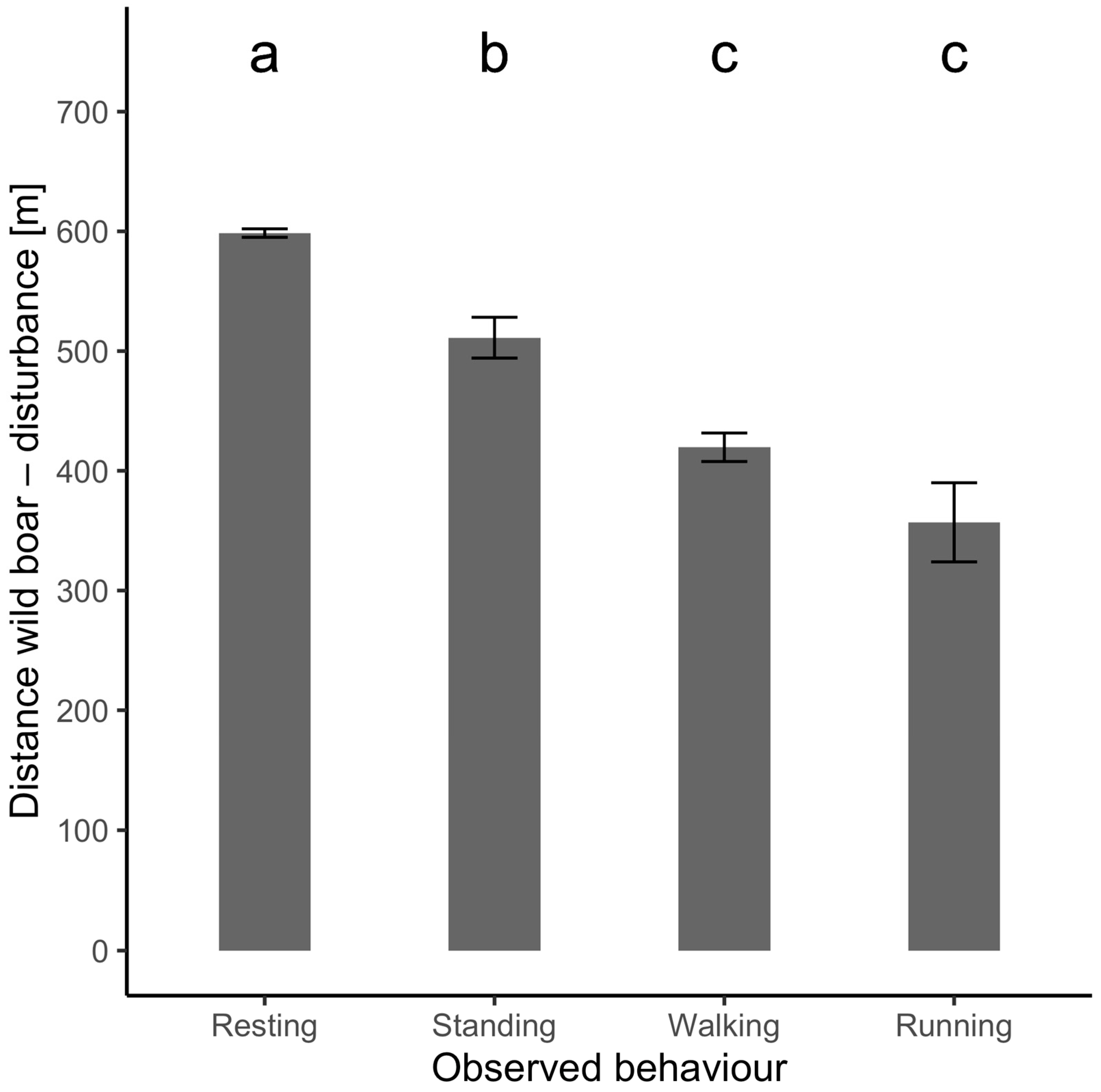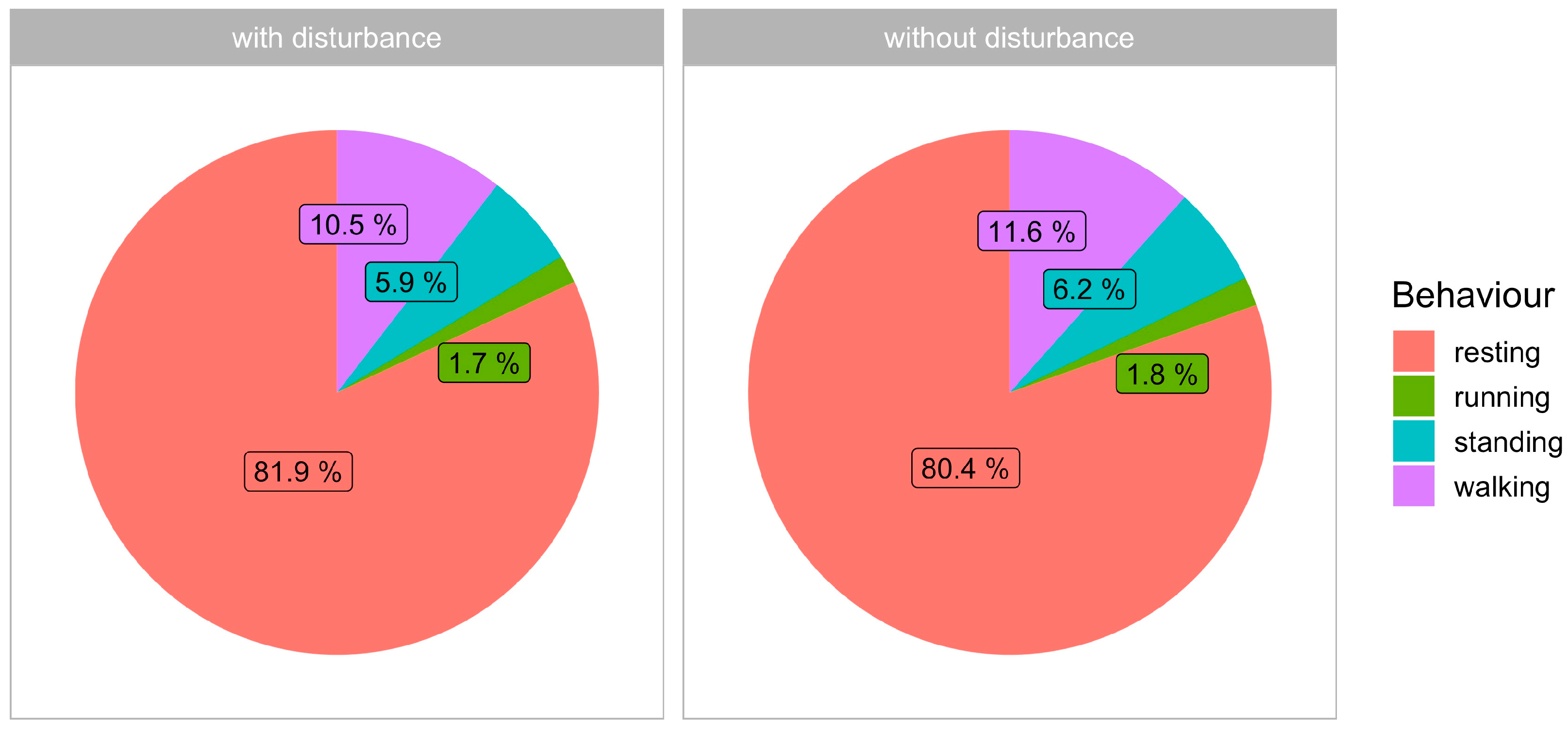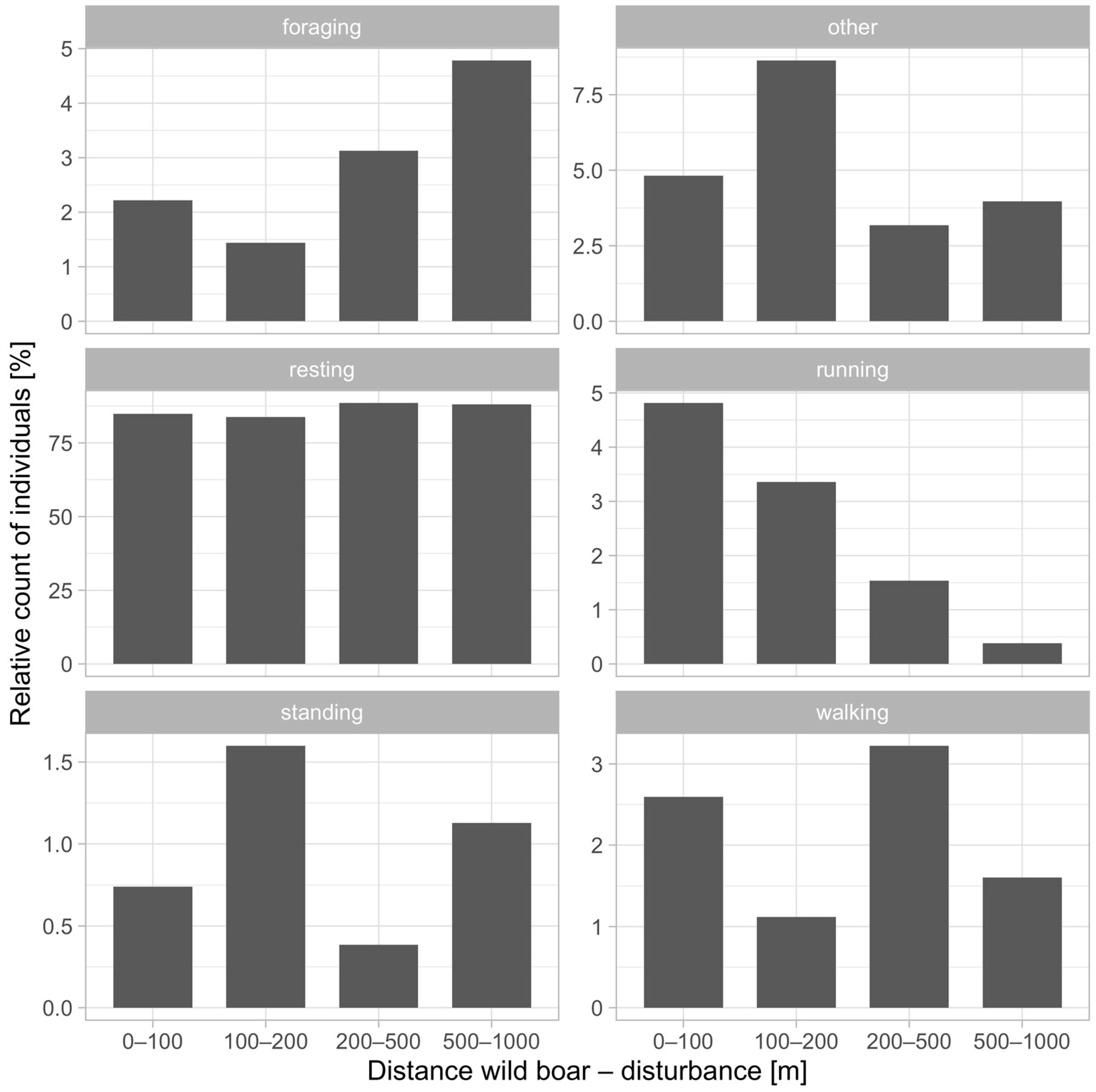Wild Boar Proves High Tolerance to Human-Caused Disruptions: Management Implications in African Swine Fever Outbreaks
Abstract
Simple Summary
Abstract
1. Introduction
2. Materials and Methods
2.1. Study Area
2.2. Data Acquisition
2.3. Dead Reckoning Procedure
2.4. Statistic Analyses
3. Results
4. Discussion
5. Conclusions
Supplementary Materials
Author Contributions
Funding
Institutional Review Board Statement
Informed Consent Statement
Data Availability Statement
Acknowledgments
Conflicts of Interest
References
- Jori, F.; Massei, G.; Licoppe, A.; Linden, A.; Václavek, P.; Chenais, E. Understanding and Combatting African Swine Fever; Wageningen Academic Publishers: Wageningen, The Netherlands, 2021; ISBN 9789086869107. [Google Scholar]
- Tack, J. Wild Boar (Sus scrofa) Populations in Europe. In A Scientific Review of Population Trends and Implications for Management; European Landowners’ Organization: Brussels, Belgium, 2018; pp. 29–30. [Google Scholar]
- Sáaez-Royuela, C.; Telleríia, J.L. The Increased Population of the Wild Boar (Sus scrofa L.) in Europe. Mamm. Rev. 1986, 16, 97–101. [Google Scholar] [CrossRef]
- Frauendorf, M.; Gethöffer, F.; Siebert, U.; Keuling, O. The Influence of Environmental and Physiological Factors on the Litter Size of Wild Boar (Sus scrofa) in an Agriculture Dominated Area in Germany. Sci. Total Environ. 2016, 541, 877–882. [Google Scholar] [CrossRef] [PubMed]
- Faltusová, M.; Ježek, M.; Ševčík, R.; Silovský, V.; Cukor, J. Odor Fences Have No Effect on Wild Boar Movement and Home Range Size. Animals 2024, 14, 2556. [Google Scholar] [CrossRef] [PubMed]
- Vetter, S.G.; Ruf, T.; Bieber, C.; Arnold, W. What Is a Mild Winter? Regional Differences in within-Species Responses to Climate Change. PLoS ONE 2015, 10, e0132178. [Google Scholar] [CrossRef] [PubMed]
- Bieber, C.; Ruf, T. Population Dynamics in Wild Boar Sus scrofa: Ecology, Elasticity of Growth Rate and Implications for the Management of Pulsed Resource Consumers. J. Appl. Ecol. 2005, 42, 1203–1213. [Google Scholar] [CrossRef]
- Keuling, O.; Podgórski, T.; Monaco, A.; Melletti, M.; Merta, D.; Albrycht, M.; Genov, P.V.; Gethöffer, F.; Vetter, S.G.; Jori, F.; et al. Ecology, conservation and management of wild pigs and peccaries. In Eurasian Wild Boar Sus scrofa (Linnaeus, 1758); Cambridge University Press: Cambridge, UK, 2017; ISBN 9781316941232. [Google Scholar]
- Touzot, L.; Schermer, É.; Venner, S.; Delzon, S.; Rousset, C.; Baubet, É.; Gaillard, J.M.; Gamelon, M. How Does Increasing Mast Seeding Frequency Affect Population Dynamics of Seed Consumers? Wild Boar as a Case Study. Ecol. Appl. 2020, 30, e02134. [Google Scholar] [CrossRef]
- Cwynar, P.; Stojkov, J.; Wlazlak, K. African Swine Fever Status in Europe. Viruses 2019, 11, 310. [Google Scholar] [CrossRef]
- Carpio, A.J.; Apollonio, M.; Acevedo, P. Wild Ungulate Overabundance in Europe: Contexts, Causes, Monitoring and Management Recommendations. Mamm. Rev. 2021, 51, 95–108. [Google Scholar] [CrossRef]
- Chenais, E.; Depner, K.; Guberti, V.; Dietze, K.; Viltrop, A.; Ståhl, K. Epidemiological Considerations on African Swine Fever in Europe 2014–2018. Porc. Health Manag. 2019, 5, 6. [Google Scholar] [CrossRef]
- Mur, L.; Atzeni, M.; Martínez-López, B.; Feliziani, F.; Rolesu, S.; Sanchez-Vizcaino, J.M. Thirty-Five-Year Presence of African Swine Fever in Sardinia: History, Evolution and Risk Factors for Disease Maintenance. Transbound. Emerg. Dis. 2016, 63, e165–e177. [Google Scholar] [CrossRef]
- Cukor, J.; Linda, R.; Václavek, P.; Šatrán, P.; Mahlerová, K.; Vacek, Z.; Kunca, T.; Havránek, F. Wild Boar Deathbed Choice in Relation to ASF: Are There Any Differences between Positive and Negative Carcasses? Prev. Vet. Med. 2020, 177, 104943. [Google Scholar] [CrossRef] [PubMed]
- Sauter-Louis, C.; Conraths, F.J.; Probst, C.; Blohm, U.; Schulz, K.; Sehl, J.; Fischer, M.; Forth, J.H.; Zani, L.; Depner, K.; et al. African Swine Fever in Wild Boar in Europe—A Review. Viruses 2021, 13, 1717. [Google Scholar] [CrossRef] [PubMed]
- Jarynowski, A.; Platek, D.; Krzowski, Ł.; Gerylovich, A.; Belik, V. African Swine Fever-Potential Biological Warfare Threat. 2019. Available online: https://www.afisapr.org.br/attachments/article/1895/EasyChair-Preprint-1904.pdf (accessed on 24 April 2024).
- Linden, A.; Licoppe, A.; Volpe, R.; Paternostre, J.; Lesenfants, C.; Cassart, D.; Garigliany, M.; Tignon, M.; van den Berg, T.; Desmecht, D.; et al. Summer 2018: African Swine Fever Virus Hits North-Western Europe. Transbound. Emerg. Dis. 2019, 66, 54–55. [Google Scholar] [CrossRef]
- Szymańska, E.J.; Dziwulaki, M. Development of African Swine Fever in Poland. Agriculture 2022, 12, 119. [Google Scholar] [CrossRef]
- Juszkiewicz, M.; Walczak, M.; Woźniakowski, G.; Podgórska, K. African Swine Fever: Transmission, Spread, and Control through Biosecurity and Disinfection, Including Polish Trends. Viruses 2023, 15, 2275. [Google Scholar] [CrossRef]
- Morelle, K.; Jezek, M.; Licoppe, A.; Podgorski, T. Deathbed Choice by ASF-Infected Wild Boar Can Help Find Carcasses. Transbound. Emerg. Dis. 2019, 66, 1821–1826. [Google Scholar] [CrossRef]
- Cukor, J.; Linda, R.; Mahlerová, K.; Vacek, Z.; Faltusová, M.; Marada, P.; Havránek, F.; Hart, V. Different Patterns of Human Activities in Nature during Covid-19 Pandemic and African Swine Fever Outbreak Confirm Direct Impact on Wildlife Disruption. Sci. Rep. 2021, 11, 20791. [Google Scholar] [CrossRef] [PubMed]
- Dellicour, S.; Desmecht, D.; Paternostre, J.; Malengreaux, C.; Licoppe, A.; Gilbert, M.; Linden, A. Unravelling the Dispersal Dynamics and Ecological Drivers of the African Swine Fever Outbreak in Belgium. J. Appl. Ecol. 2020, 57, 1619–1629. [Google Scholar] [CrossRef]
- Martin, J.G.A.; Réale, D. Animal Temperament and Human Disturbance: Implications for the Response of Wildlife to Tourism. Behav. Process. 2008, 77, 66–72. [Google Scholar] [CrossRef]
- Scheijen, C.P.J.; van der Merwe, S.; Ganswindt, A.; Deacon, F. Anthropogenic Influences on Distance Traveled and Vigilance Behavior and Stress-Related Endocrine Correlates in Free-Roaming Giraffes. Animals 2021, 11, 1239. [Google Scholar] [CrossRef]
- Ohashi, H.; Saito, M.; Horie, R.; Tsunoda, H.; Noba, H.; Ishii, H.; Kuwabara, T.; Hiroshige, Y.; Koike, S.; Hoshino, Y.; et al. Differences in the Activity Pattern of the Wild Boar Sus scrofa Related to Human Disturbance. Eur. J. Wildl. Res. 2013, 59, 167–177. [Google Scholar] [CrossRef]
- Pickering, C.M.; Hill, W.; Newsome, D.; Leung, Y.F. Comparing Hiking, Mountain Biking and Horse Riding Impacts on Vegetation and Soils in Australia and the United States of America. J. Environ. Manag. 2010, 91, 551–562. [Google Scholar] [CrossRef]
- Tolvanen, A.; Kangas, K. Tourism, Biodiversity and Protected Areas—Review from Northern Fennoscandia. J. Environ. Manag. 2016, 169, 58–66. [Google Scholar] [CrossRef]
- Fischer, L.K.; Kowarik, I. Dogwalkers’ Views of Urban Biodiversity across Five European Cities. Sustainability 2020, 12, 3507. [Google Scholar] [CrossRef]
- Uchida, K.; Blumstein, D.T. Habituation or Sensitization? Long-Term Responses of Yellow-Bellied Marmots to Human Disturbance. Behav. Ecol. 2021, 32, 668–678. [Google Scholar] [CrossRef]
- Hawkins, E.; Papworth, S. Little Evidence to Support the Risk–Disturbance Hypothesis as an Explanation for Responses to Anthropogenic Noise by Pygmy Marmosets (Cebuella niveiventris) at a Tourism Site in the Peruvian Amazon. Int. J. Primatol. 2022, 43, 1110–1132. [Google Scholar] [CrossRef]
- Tablado, Z.; Jenni, L. Determinants of Uncertainty in Wildlife Responses to Human Disturbance. Biol. Rev. 2017, 92, 216–233. [Google Scholar] [CrossRef]
- Skarin, A.; Åhman, B. Do Human Activity and Infrastructure Disturb Domesticated Reindeer? The Need for the Reindeer’s Perspective. Polar Biol. 2014, 37, 1041–1054. [Google Scholar] [CrossRef]
- Hebblewhite, M.; Haydon, D.T. Distinguishing Technology from Biology: A Critical Review of the Use of GPS Telemetry Data in Ecology. Philos. Trans. R. Soc. B Biol. Sci. 2010, 365, 2303–2312. [Google Scholar] [CrossRef]
- Shepard, E.L.C.; Wilson, R.P.; Halsey, L.G.; Quintana, F.; Laich, A.G.; Gleiss, A.C.; Liebsch, N.; Myers, A.E.; Norman, B. Derivation of Body Motion via Appropriate Smoothing of Acceleration Data. Aquat. Biol. 2008, 4, 235–241. [Google Scholar] [CrossRef]
- Williams, H.J.; Holton, M.D.; Shepard, E.L.C.; Largey, N.; Norman, B.; Ryan, P.G.; Duriez, O.; Scantlebury, M.; Quintana, F.; Magowan, E.A.; et al. Identification of Animal Movement Patterns Using Tri-Axial Magnetometry. Mov. Ecol. 2017, 5, 6. [Google Scholar] [CrossRef] [PubMed]
- Wilson, R.P.; Shepard, E.L.C.; Liebsch, N. Prying into the Intimate Details of Animal Lives: Use of a Daily Diary on Animals. Endanger. Species Res. 2008, 4, 123–137. [Google Scholar] [CrossRef]
- Wilson, R.P.; Liebsch, N.; Davies, I.M.; Quintana, F.; Weimerskirch, H.; Storch, S.; Lucke, K.; Siebert, U.; Zankl, S.; Müller, G.; et al. All at Sea with Animal Tracks; Methodological and Analytical Solutions for the Resolution of Movement. Deep. Res. Part II Top. Stud. Oceanogr. 2007, 54, 193–210. [Google Scholar] [CrossRef]
- Wilson, R.P.; Rose, K.A.R.; Metcalfe, R.S.; Holton, M.D.; Redcliffe, J.; Gunner, R.; Börger, L.; Loison, A.; Jezek, M.; Painter, M.S.; et al. Path Tortuosity Changes the Transport Cost Paradigm in Terrestrial Animals. Ecography 2021, 44, 1524–1532. [Google Scholar] [CrossRef]
- Walker, J.S.; Jones, M.W.; Laramee, R.S.; Holton, M.D.; Shepard, E.L.C.; Williams, H.J.; Michael Scantlebury, D.; Marks, N.J.; Magowan, E.A.; Maguire, I.E.; et al. Prying into the Intimate Secrets of Animal Lives; Software beyond Hardware for Comprehensive Annotation in ‘Daily Diary’ Tags. Mov. Ecol. 2015, 3, 29. [Google Scholar] [CrossRef]
- Painter, M.S.; Blanco, J.A.; Malkemper, E.P.; Anderson, C.; Sweeney, D.C.; Hewgley, C.W.; Červený, J.; Hart, V.; Topinka, V.; Belotti, E.; et al. Use of Bio-Loggers to Characterize Red Fox Behavior with Implications for Studies of Magnetic Alignment Responses in Free-Roaming Animals. Anim. Biotelemetry 2016, 4, 20. [Google Scholar] [CrossRef]
- Bosch, J.; Rodríguez, A.; Iglesias, I.; Muñoz, M.J.; Jurado, C.; Sánchez-Vizcaíno, J.M.; de la Torre, A. Update on the Risk of Introduction of African Swine Fever by Wild Boar into Disease-Free European Union Countries. Transbound. Emerg. Dis. 2017, 64, 1424–1432. [Google Scholar] [CrossRef]
- More, S.; Miranda, M.A.; Bicout, D.; Bøtner, A.; Butterworth, A.; Calistri, P.; Edwards, S.; Garin-Bastuji, B.; Good, M.; Michel, V.; et al. African Swine Fever in Wild Boar. EFSA J. 2018, 16, e05344. [Google Scholar]
- Podgórski, T.; Śmietanka, K. Do Wild Boar Movements Drive the Spread of African Swine Fever? Transbound. Emerg. Dis. 2018, 65, 1588–1596. [Google Scholar] [CrossRef]
- Probst, C.; Globig, A.; Knoll, B.; Conraths, F.J.; Depner, K. Behaviour of Free Ranging Wild Boar towards Their Dead Fellows: Potential Implications for the Transmission of African Swine Fever. R. Soc. Open Sci. 2017, 4, 170054. [Google Scholar] [CrossRef]
- Cukor, J.; Linda, R.; Václavek, P.; Mahlerová, K.; Šatrán, P.; Havránek, F. Confirmed Cannibalism in Wild Boar and Its Possible Role in African Swine Fever Transmission. Transbound. Emerg. Dis. 2020, 67, 1068–1073. [Google Scholar] [CrossRef] [PubMed]
- Desmecht, D.; Gerbier, G.; Gortázar Schmidt, C.; Grigaliuniene, V.; Helyes, G.; Kantere, M.; Korytarova, D.; Linden, A.; Miteva, A.; Neghirla, I.; et al. Epidemiological Analysis of African Swine Fever in the European Union (September 2019 to August 2020). EFSA J. 2021, 19, e06572. [Google Scholar] [CrossRef] [PubMed]
- Dei Giudici, S.; Loi, F.; Ghisu, S.; Angioi, P.P.; Zinellu, S.; Fiori, M.S.; Carusillo, F.; Brundu, D.; Franzoni, G.; Zidda, G.M.; et al. The Long-Jumping of African Swine Fever: First Genotype II Notified in Sardinia, Italy. Viruses 2024, 16, 32. [Google Scholar] [CrossRef] [PubMed]
- Gervasi, V.; Sordilli, M.; Loi, F.; Guberti, V. Estimating the Directional Spread of Epidemics in Their Early Stages Using a Simple Regression Approach: A Study on African Swine Fever in Northern Italy. Pathogens 2023, 12, 812. [Google Scholar] [CrossRef] [PubMed]
- Podgórski, T.; Baś, G.; Jȩdrzejewska, B.; Sönnichsen, L.; Śniezko, S.; Jȩdrzejewski, W.; Okarma, H. Spatiotemporal Behavioral Plasticity of Wild Boar (Sus scrofa) under Contrasting Conditions of Human Pressure: Primeval Forest and Metropolitan Area. J. Mammal. 2013, 94, 109–119. [Google Scholar] [CrossRef]
- Csókás, A.; Schally, G.; Szabó, L.; Csányi, S.; Kovács, F.; Heltai, M. Space Use of Wild Boar (Sus scrofa) in Budapest: Are They Resident or Transient City Dwellers? Biol. Futur. 2020, 71, 39–51. [Google Scholar] [CrossRef]
- Castillo-Contreras, R.; Carvalho, J.; Serrano, E.; Mentaberre, G.; Fernández-Aguilar, X.; Colom, A.; González-Crespo, C.; Lavín, S.; López-Olvera, J.R. Urban Wild Boars Prefer Fragmented Areas with Food Resources near Natural Corridors. Sci. Total Environ. 2018, 615, 282–288. [Google Scholar] [CrossRef]
- Ciuti, S.; Northrup, J.M.; Muhly, T.B.; Simi, S.; Musiani, M.; Pitt, J.A.; Boyce, M.S. Effects of Humans on Behaviour of Wildlife Exceed Those of Natural Predators in a Landscape of Fear. PLoS ONE 2012, 7, e50611. [Google Scholar] [CrossRef]
- Scillitani, L.; Monaco, A.; Toso, S. Do Intensive Drive Hunts Affect Wild Boar (Sus scrofa) Spatial Behaviour in Italy? Some Evidences and Management Implications. Eur. J. Wildl. Res. 2010, 56, 307–318. [Google Scholar] [CrossRef]
- Drimaj, J.; Kamler, J.; Plhal, R.; Janata, P.; Adamec, Z.; Homolka, M. Intensive Hunting Pressure Changes Local Distribution of Wild Boar. Hum.-Wildl. Interact. 2021, 15, 22–31. [Google Scholar] [CrossRef]
- Keuling, O.; Massei, G. Does Hunting Affect the Behavior of Wild Pigs? Hum.-Wildl. Interact. 2021, 15, 44–55. [Google Scholar] [CrossRef]
- Guinat, C.; Vergne, T.; Jurado-Diaz, C.; Sánchez-Vizcaíno, J.M.; Dixon, L.; Pfeiffer, D.U. Scientific Opinion on African Swine Fever. EFSA J. 2010, 8, 97. [Google Scholar] [CrossRef]
- Guinat, C.; Vergne, T.; Jurado-Diaz, C.; Sánchez-Vizcaíno, J.M.; Dixon, L.; Pfeiffer, D.U. Effectiveness and Practicality of Control Strategies for African Swine Fever: What Do We Really Know? Vet. Rec. 2017, 180, 97. [Google Scholar] [CrossRef]
- Miteva, A.; Papanikolaou, A.; Gogin, A.; Boklund, A.; Bøtner, A.; Linden, A.; Viltrop, A.; Schmidt, C.G.; Ivanciu, C.; Desmecht, D.; et al. Epidemiological Analyses of African Swine Fever in the European Union (November 2018 to October 2019). EFSA J. 2020, 18, e05996. [Google Scholar] [CrossRef]






Disclaimer/Publisher’s Note: The statements, opinions and data contained in all publications are solely those of the individual author(s) and contributor(s) and not of MDPI and/or the editor(s). MDPI and/or the editor(s) disclaim responsibility for any injury to people or property resulting from any ideas, methods, instructions or products referred to in the content. |
© 2024 by the authors. Licensee MDPI, Basel, Switzerland. This article is an open access article distributed under the terms and conditions of the Creative Commons Attribution (CC BY) license (https://creativecommons.org/licenses/by/4.0/).
Share and Cite
Faltusová, M.; Cukor, J.; Linda, R.; Silovský, V.; Kušta, T.; Ježek, M. Wild Boar Proves High Tolerance to Human-Caused Disruptions: Management Implications in African Swine Fever Outbreaks. Animals 2024, 14, 2710. https://doi.org/10.3390/ani14182710
Faltusová M, Cukor J, Linda R, Silovský V, Kušta T, Ježek M. Wild Boar Proves High Tolerance to Human-Caused Disruptions: Management Implications in African Swine Fever Outbreaks. Animals. 2024; 14(18):2710. https://doi.org/10.3390/ani14182710
Chicago/Turabian StyleFaltusová, Monika, Jan Cukor, Rostislav Linda, Václav Silovský, Tomáš Kušta, and Miloš Ježek. 2024. "Wild Boar Proves High Tolerance to Human-Caused Disruptions: Management Implications in African Swine Fever Outbreaks" Animals 14, no. 18: 2710. https://doi.org/10.3390/ani14182710
APA StyleFaltusová, M., Cukor, J., Linda, R., Silovský, V., Kušta, T., & Ježek, M. (2024). Wild Boar Proves High Tolerance to Human-Caused Disruptions: Management Implications in African Swine Fever Outbreaks. Animals, 14(18), 2710. https://doi.org/10.3390/ani14182710






